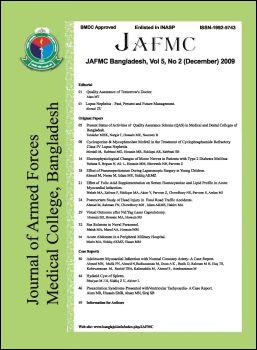Electrophysiological Changes of Motor Nerves in Patients with Type 2 Diabetes Mellitus
DOI:
https://doi.org/10.3329/jafmc.v5i2.4576Keywords:
Diabetic neuropathy, electrophysiology, nerve conduction, electromyographyAbstract
Peripheral neuropathy is a common disabling complication in patients with diabetes and this complication is related to the duration of the disease process. Nerve conduction study is widely used for the assessment of diabetic polyneuropathy not only to evaluate the degree of abnormality but also to document serial changes in the clinical course of the disease. This study was designed to characterize motor nerve conduction abnormalities in subjects having relatively shorter and longer duration of type 2 diabetes mellitus and also to assess whether time related variable like duration of diabetes has any influence on motor nerve function of the subjects. Forty-four type 2 diabetic subjects were included in two groups:- Group B consisted of 23 diabetic subjects having duration of diabetes for 5-10 years (shorter duration) and Group C consisted of 21 diabetic subjects having duration of diabetes for 10-15 years (longer duration). Twenty-five age and BMI matched healthy subjects without family history of diabetes were included as Group A (non-diabetic) subjects. Motor nerve conduction velocities, action potential amplitudes and latencies of ulnar and peroneal nerves were measured by standard Nerve Conduction Velocity- Electromyography (NCV-EMG) equipment.
Motor conduction parameters like ulnar compound muscle action potential (U CMAP), peroneal compound muscle action potential (P CMAP) and peroneal nerve conduction velocity (P NCV) were found to be significantly reduced (p<0.001, <0.01, <0.01 respectively) in diabetic group with shorter duration of diabetes(Group B) in comparison to non-diabetic control group (Group A). In the diabetic group with relatively longer duration of diabetes (Group C) motor nerve conduction parameters like U CMAP and P NCV were significantly reduced (p<0.001, <0.01 respectively). The results showed that in the type 2 diabetic population, motor nerve conduction parameters were affected early and there was gradual deterioration of motor function as duration of diabetes increased. Though previous studies on diabetic neuropathy suggest that abnormalities of sensory nerve conduction are early features of diabetic nerve damage and sensory nerves are more susceptible to fall prey to metabolic assaults, the present study indicates that motor nerves are also involved and the neuropathic changes assessed by electro diagnostic methods in motor nerves may occur early in patients with type 2 diabetes mellitus. So, there may be some genetic and biochemical basis (other than hyperglycaemia) for early motor involvement in type 2 diabetic population of Bangladesh.
Key words: Diabetic neuropathy, electrophysiology, nerve conduction, electromyography.
DOI: 10.3329/jafmc.v5i2.4576
JAFMC Bangladesh Vol.5(2) (December) 2009, pp.14-17
Downloads
180
426

